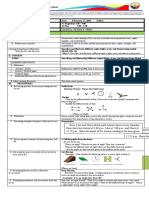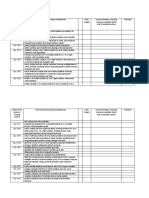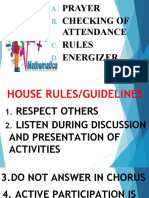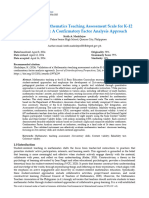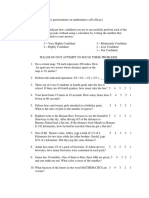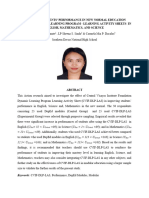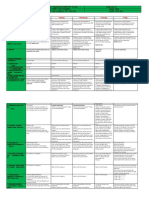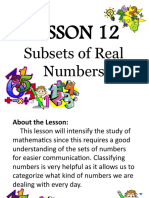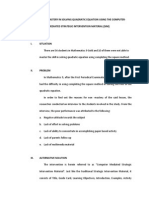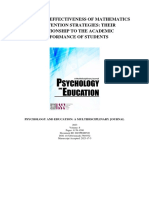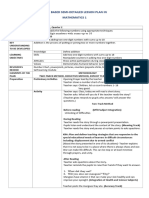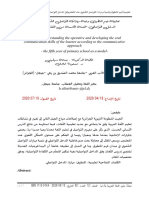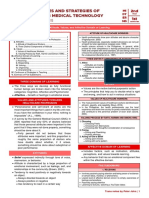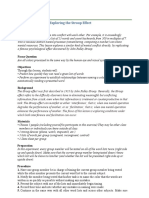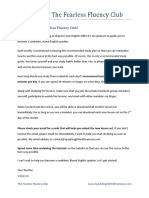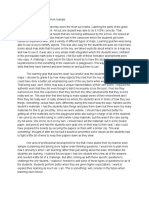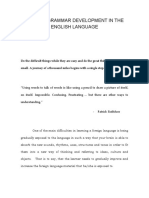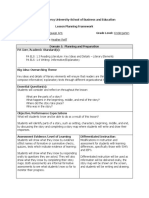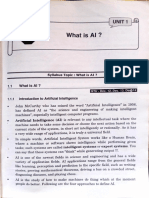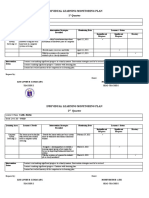Effective Teaching Strategies in Mathematics
(Introduction)
As we live our daily life, mathematics also has become part of our daily lives-making
budget for the day for groceries and shopping, measuring the ingredients for making food,
time management, and the like. It was stressed by Glenda Anthony and Margaret Walshaw
(2009) mathematics is the most international of all curriculum subjects, and mathematical
understanding influences decision making in all areas of life—private, social, and civil .
Likewise, Professor Adrian Smith (2004) stated that the society recognizes the importance of
mathematics: the importance for its own sake, as an intellectual discipline; for the knowledge
economy; for science, technology and engineering; for the workplace; and for the individual
citizen. Boaler (2009); Devlin (2002); du Sautoy (2010) states that in an increasingly
technological world, an understanding of mathematics becomes ever more important.
Understanding of our world demands what is often called “mathematical literacy”. The
Organization for Economic Co-operation and Development (OECD) uses the term
“mathematical literacy”, defining it as: the capacity to identify, to understand and to engage in
mathematics as well-founded judgments about the role that mathematics plays, as needed for an
individual’s current and future private life, social life with peers and relatives, and life as a
constructive, concerned, and reflective citizen (OECD 1999:50). Moreover, mathematics has
importance over and above the application of basic numeracy skills. It is also the prime vehicle
for developing student’s logical thinking and higher-order cognitive skills (Marissa R. Guiab and
Nicette N. Ganal 2014).
As mathematics become part of our daily life and a subject in the basic education many
students still struggle to understand the concept of mathematics and its application in real life
situation. In its report published in July 1977, the Education, Arts and Home Office Sub-
Committee of the Parliamentary Expenditure Committee stated that 'it is clear from the points
which were made over and over again by witnesses that there is a large number of questions
about the mathematical attainments of students which need much more careful analysis than we
have been able to give during our enquiry. These concern the apparent lack of basic computation
skills in many children, the increasing mathematical demands made on adults, the lack of
qualified mathematics teachers, the multiplicity of syllabuses for old, new and mixed
mathematics, the lack of communication between further and higher education, employers and
schools about each group's needs and viewpoints, the inadequacy of information on job content
or test results over a period of time, and the responsibility of teachers of mathematics and other
subjects to equip students with the skills of numeracy' (Dr. Wilfred Cockcroft et. Al 1982).
Likewise, (Terezinha Nunes Carraher, Analucia Dias Schliemann, David William Carraher
1993) suggested that educators should question the practice of treating mathematical systems as
formal subjects from the outset and should instead seek ways of introducing these systems in
contexts which allow them to be sustained by human daily sense. Thus, educators must find
ways and innovate the way of teaching students where they can relate mathematical concepts in
real life situation and catch their students interest in learning the subject and also making their
students enjoy learning mathematics not as a subject but as a weapon to be used in real life
battles.
� Mathematical literacy is defined as: "an individual's capacity to formulate, employ and
interpret mathematics in a variety of contexts. It includes reasoning mathematically and using
mathematical concepts, procedures, facts and tools to describe, explain and predict phenomena
(OECD, 2018, p. 67). Likewise, (Kramarski, Bracha; Mizrachi, Nava 2004) stated that
Mathematical literacy” is used here to indicate the ability to put mathematical knowledge and
skills to use rather than just mastering them within a school curriculum. A high level of
mathematical literacy is integral to understanding the role of mathematics in the world, carrying
out mathematics-related applications in daily life, and developing numerical, spatial, and critical
thinking skills (Özgen & Bindak, 2008). The ability to analyze mathematics problems involves
understanding mathematical statements and expressions, both of which require a high level of
mathematical literacy (Gellert, Jablonka & Keitel, 2001; Pugalee, 1999). Doyle (2005) explained
that students who have poor literacy skills inevitably have poor problem-solving skills when
problems require reading and interpreting texts, because they cannot glean sufficient meaning
from the text. Furthermore, Miller and Koesling (2009) explained that literacy plays a role in
teaching students to solve complex word problems, read mathematics text, and come to a better
understanding of mathematics instruction. In the same way problem-based learning is a learning
that utilizes problems, questions, or puzzle as a trigger for the students' learning process (CIDR,
2004). Padmavathy and Mareesh (2013) study revealed the effect of problem-based learning in
teaching mathematics to enhance students' understanding, and the ability to use the concept in
real life. The definition concerns doing and using mathematics in situations that range from the
everyday to the unusual and from the simple to the complex (OECD, 2009, 2012). Hence,
development of students ‘mathematical literacy will influence their confidence and competence
in mathematics and prepare them for the application and future learning of mathematics in higher
education and outside classroom (OECD, 2003)
Generally, it is an alarming observation among Filipino students that they excel in
knowledge acquisition but fare considerably low in lessons requiring higher order thinking skills.
These sorry states evident in the performance of students in national and international surveys on
Mathematics and Science competencies. Separate studies on the mathematics performance of
preservice teachers(Philippine Daily Inquirer, 1988, p. 14 in Ayap,2007) and mathematics
teachers on the 1993 and 1994Professional Board Examination for Teachers (Ibe, 1995 in
Aguinaldo,2008) reveal the same dismal picture of mathematics competencies of those who
intend to teach it as well as those who have been teaching at the elementary and secondary
levels.
Carabbacan (2003 in Ayap,2007) asserted that the teacher in the classroom is the central
figure who provides the structure within which the children can learn. In fact, the way the teacher
presents an activity or concept, strongly influences the way the learners react to it. An effective
teacher utilizes a variety of techniques and strategies to develop productive discipline and to
motivate learners. The study of House (2001) on the relationship between instructional activities
and mathematics achievement of adolescents in Japan found out that students tended to show
higher mathematics achievement when their teachers more frequently explained rules and
definitions. Similarly, students performed higher mathematics test scores when their teachers
more frequently solved an example related to the new topic.
According to Sin Son (2003 in Mateo,2011), the teacher is the most critical factor in
attaining quality education and the single most potent element in the complete structure of an
�effective mathematical program. Likewise, Carabbacan (2003 in Ayap,2007) asserted that the
teacher in the classroom is the central figure who provides the structure within which the
children can learn. Thus, educators must find a way to provide an efficient and effective way to
teach the learners for them to be able to understand the lessons and also to apply it in real life
situations. That being said, teacher’s knowledge and mastery of the subject will also affect the
efficiency and effectivity of the learning process. One also of the factors that can cause the
teaching-learning process is the level of the communication of the teacher which can be a big
factor because it is through his explanations where the students learning will depend. Identifying
the problems commonly faced by students is important for teachers to reduce or better eliminate
them so that students can in a large and meaningful way achieve the competencies in
mathematics as showcased in their improved performance. As other researchers have pointed
out, the teachers are the primary cause of students’ failure in mathematics. Poor performance in
mathematics can be traced back to teachers’ failure to impart the necessary knowledge, skills,
attitudes, and values to students (Marissa R. Guiab and Nicette N. Ganal 2014).
With all the above mentioned about mathematical literacy the research is focused on the
ways of educators can implement the concept of mathematics in which students can understand
and enjoy mathematics and can be used in their future. (Dilek Sezgin Memnun, Ph.D., Uludag
University, Turkey Recai Akkaya, Ph.D., Abant Izzet Baysal University, Turkey Güney
Hacıömeroğlu, Ph.D., Canakkale Onsekiz Mart University, Turkey 2012) suggested that teachers
should be able to think critically and creatively, should possess mathematical reasoning skills,
and should be confident in their knowledge base and abilities to relate mathematical concepts to
their students. Self-efficacy beliefs - in this case, the beliefs of students regarding their abilities
to implement the knowledge provided to them in order to achieve an objective - are key If
students’ beliefs about their own self-efficacy are strong, they are more receptive to teaching and
more willing to learn (Bandura, 1986; Schunk, 1989 and 1992; Cited in Alcı & Altun, 2007).
Thus, prospective teachers must be aware of and try to cultivate their students’ self-efficacy
about mathematical literacy (Özgen & Bindak, 2008).






